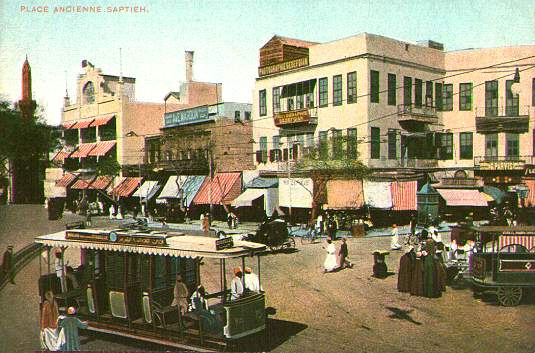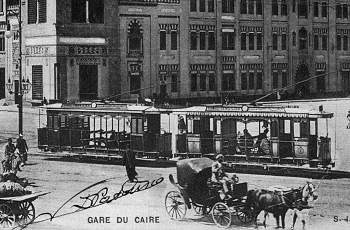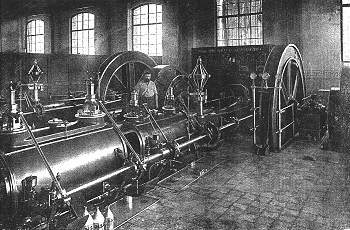

In its heyday, Egypt's Cairo tramway network was the largest in Africa. Our main postcard features car 75 of the Cairo fleet at Place Ancienne, Saptieh (modern spelling Sabtiya or Zabtiyeh) in the central area. Its side destination indicator shows "Boulaq - Citadelle", all tram destinations at that time being in French and Arabic and having a route colour in a disc, white in this case. The bus on the right of the view is on a route to Ataba-el-Khadra. The card is number 2 in a series produced in about 1907 by Cairo publisher Lichtenstern & Harari.
The small view (below) shows two more trams of similar types on the route to "Canal Ishmailien", outside Cairo Main Station in what is now known as Midan Ramses (Ramesses Square). It is an extract from a card by publisher S.I.P. and our copy was posted from Cairo on 12th June 1909 to Kuopio in Finland. Our third view is an official photograph from "Railway World" in 1899 and shows one of the horizontal compound condensing steam engines of Boulaq power station.
See note on Egyptian Place Names.
The tramway was owned by the Société Anonyme des Tramways du Caire of Brussels, Belgium, formed jointly by Edouard Empain's tramway and financial empire and the Société Générale de Chemins de Fer Économiques, another large Belgian tramway group. The concession for the tramway was obtained on 5th December 1894. The metre gauge lines were constructed during 1895 by the Union Elektricitäts Gesellschaft (UEG) of Berlin, Germany under the American patents of the General Electric Company. After trial runs on 1st August 1896, the initial routes opened to traffic on the 12th August, with additional routes opening later that year. In early years there were ten routes giving nearly twelve miles of mostly double track. The steepest gradient was 1 in 12.5 and the sharpest curve was 100 feet radius. Current collection was by trolley pole from 8 mm drawn copper overhead wire.
 The first fleet was 40 motor cars, plus 20 trailers. Building of the bodies was shared between Belgian manufacturers Franco-Belge at La Croyère and La Métallurgique at Nivelles. They were 8.4 metres long (over bumpers) and 2.165 metres wide. The motor cars were mounted on UEG 4-wheel 1.8 metre wheelbase trucks, each with two 22-horsepower General Electric G.E. 800 motors. They had hand brakes and UEG controllers which could also apply emergency reverse polarity electrical braking. Additional cars were soon added as track length was extended to 24 miles, including the single-track line to the Pyramids at Giza which opened in 1899 (mostly doubled in 1902). The majority of these early cars were single-deck with open sides and typically seating 32 or 40 on cross bench seats, plus room for 6 standing passengers. The configuration of the seating varied from batch to batch, as can be seen on the three trams in our views. There were separate compartments, 1st class usually used by Europeans, 2nd class by Arabs and fellaheen. They also had a harem compartment, enclosed with louvre windows, such as can be seen on the left hand car in our small view. The ten cars for the Pyramids route (increased by 1906 to 22) from Nivelles had an enclosed saloon and seated 24 in two compartments (1st and 2nd class) and allowed 14 standees. By 1901 there were 131 motor cars and 79 trailers in the Cairo fleet and passenger numbers had risen to 15 million per year. The main livery was cream (in modern times cream with a red line or blue and white).
The first fleet was 40 motor cars, plus 20 trailers. Building of the bodies was shared between Belgian manufacturers Franco-Belge at La Croyère and La Métallurgique at Nivelles. They were 8.4 metres long (over bumpers) and 2.165 metres wide. The motor cars were mounted on UEG 4-wheel 1.8 metre wheelbase trucks, each with two 22-horsepower General Electric G.E. 800 motors. They had hand brakes and UEG controllers which could also apply emergency reverse polarity electrical braking. Additional cars were soon added as track length was extended to 24 miles, including the single-track line to the Pyramids at Giza which opened in 1899 (mostly doubled in 1902). The majority of these early cars were single-deck with open sides and typically seating 32 or 40 on cross bench seats, plus room for 6 standing passengers. The configuration of the seating varied from batch to batch, as can be seen on the three trams in our views. There were separate compartments, 1st class usually used by Europeans, 2nd class by Arabs and fellaheen. They also had a harem compartment, enclosed with louvre windows, such as can be seen on the left hand car in our small view. The ten cars for the Pyramids route (increased by 1906 to 22) from Nivelles had an enclosed saloon and seated 24 in two compartments (1st and 2nd class) and allowed 14 standees. By 1901 there were 131 motor cars and 79 trailers in the Cairo fleet and passenger numbers had risen to 15 million per year. The main livery was cream (in modern times cream with a red line or blue and white).
 The power station was located at Boulaq near the Nile. It used Nile water for steam condensing, extracted by three electric centrifugal pumps and stored in a reservoir to allow settling. The depot and workshops were nearby, although more depots were added later and a new maintenance workshop was built at Abbassieh in around 1910. By 1899 the power station had six Cornish boilers (three at first) from Tosi of Milan, each with a heating surface of 1,184 sq. ft., producing steam at a pressure of 10.5 atmospheres. There were four Sulzer horizontal compound condensing engines working at 8 atmospheres and 120 r.p.m., giving a maximum capacity of 400 horsepower each. Electricity at 550 volts D.C. was delivered by four UEG dynamos, each rated at 225 kilowatts. All lighting on the tramway premises was electrically powered.
The power station was located at Boulaq near the Nile. It used Nile water for steam condensing, extracted by three electric centrifugal pumps and stored in a reservoir to allow settling. The depot and workshops were nearby, although more depots were added later and a new maintenance workshop was built at Abbassieh in around 1910. By 1899 the power station had six Cornish boilers (three at first) from Tosi of Milan, each with a heating surface of 1,184 sq. ft., producing steam at a pressure of 10.5 atmospheres. There were four Sulzer horizontal compound condensing engines working at 8 atmospheres and 120 r.p.m., giving a maximum capacity of 400 horsepower each. Electricity at 550 volts D.C. was delivered by four UEG dynamos, each rated at 225 kilowatts. All lighting on the tramway premises was electrically powered.
Changes to rules in 1906 meant cars could no longer pull two trailers, so 30 surplus trailers were converted to motor cars. In 1908 the Cairo tramway was joined to that of the nearby new town of Heliopolis (see Postcard), another Empain venture, to which it was also linked in 1910 by a high speed "metro" tramway. From 1913 new cars all had enclosed saloons. By its peak size in the 1930s the Cairo system had grown to nearly 44 route miles on 20 routes with 383 motor cars and nearly 300 trailers, with many of the original crossbench cars still in service, and in 1944 carried 186 million passengers. Until the 1950s new trams were of Belgian manufacture, whereas trams of the 1970s and 80s were mostly Japanese or of Japanese design built locally. In the 1970s PCC cars ex Los Angeles and new Tatra cars were used, but these had been withdrawn by the mid 1980s. From 1950 trolleybuses were used on 12 routes, some replacing trams, but the fleet of 160 had gone by 1981. A number of tram routes closed in the 1950s, including in 1957 the Pyramids route.
The Belgian concession had been extended to 1951 and then 1978, but in 1960 the tramway was nationalised, although the shareholders received no compensation until 1976. The tramway was then operated by the Cairo Transport Authority (CTA). By the 1990s increased road congestion and then the building of the Underground Metro caused reductions in tram services and by the end of the decade the last of the Cairo urban tram lines had closed. However, the "metro" tram continues to run from Midan Ramses to Heliopolis and Cairo trams still operate five routes in Heliopolis itself from Shari Port Said depot. Worth noting is that trams of the same type as the latest ones in Cairo, are operated by the CTA in the industrial town of Helwan, 16 miles to the south of the city.
![]() Go to Postcard Of The Month Index
Go to Postcard Of The Month Index